Report: Maximizing Stakeholder Value at DSB Bank - Finance
VerifiedAdded on 2023/01/13
|8
|1362
|31
Report
AI Summary
This report presents an executive summary and detailed analysis of DSB Bank's financial performance, focusing on maximizing stakeholder value. It examines various strategies, including strategic decisions, mergers and acquisitions, and rewarding employees, to enhance stakeholder value. The report also analyzes the bank's dividend policy, considering factors like earnings stability, financing policies, and liquidity, and discusses the impact of dividend policies on capital structure. Furthermore, it evaluates the bank's capital structure, debt-equity ratio, and key financial ratios, such as current ratio and return on equity (ROE), to assess its financial health and investment potential. The report concludes with an investment recommendation based on the bank's performance and financial stability. The analysis includes data from 2017 and 2018, offering insights into the bank's financial trends and strategic decisions.
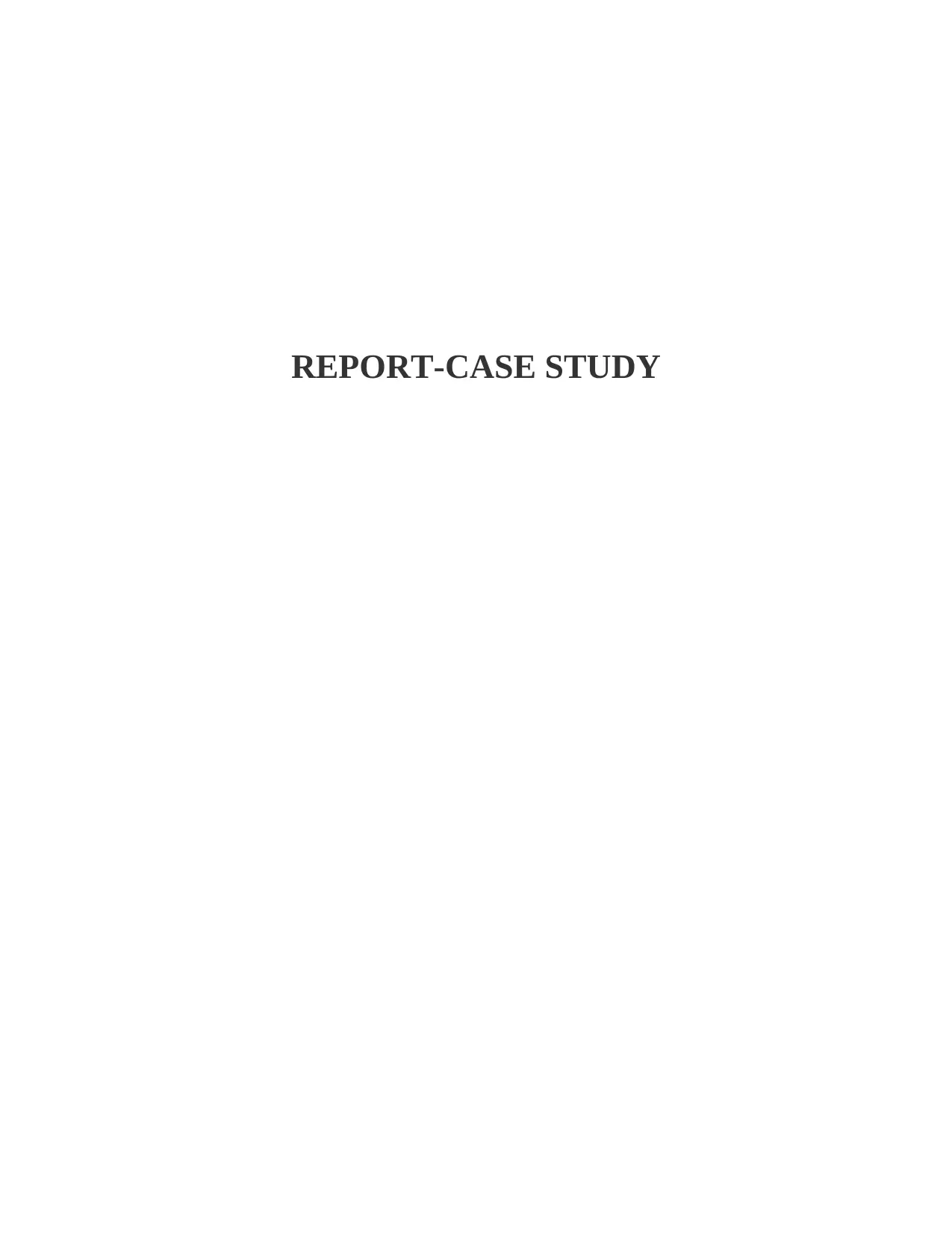
REPORT-CASE STUDY
Paraphrase This Document
Need a fresh take? Get an instant paraphrase of this document with our AI Paraphraser

EXECUTIVE SUMMARY
Banks operated in very competitive environment and due to this reason, it become very
important for it to receive full support from the stakeholders. There are number of ways in
which value for the stakeholders can be maximized by the business firm like reward can be given
to the employees. Through M&A operations profit can be maximized and better return can be
given to the stakeholders. DSB. In the report it is also identified that bank is performing and
financially it is strong. Thus, investors can make investment in the DSB shares.
Banks operated in very competitive environment and due to this reason, it become very
important for it to receive full support from the stakeholders. There are number of ways in
which value for the stakeholders can be maximized by the business firm like reward can be given
to the employees. Through M&A operations profit can be maximized and better return can be
given to the stakeholders. DSB. In the report it is also identified that bank is performing and
financially it is strong. Thus, investors can make investment in the DSB shares.
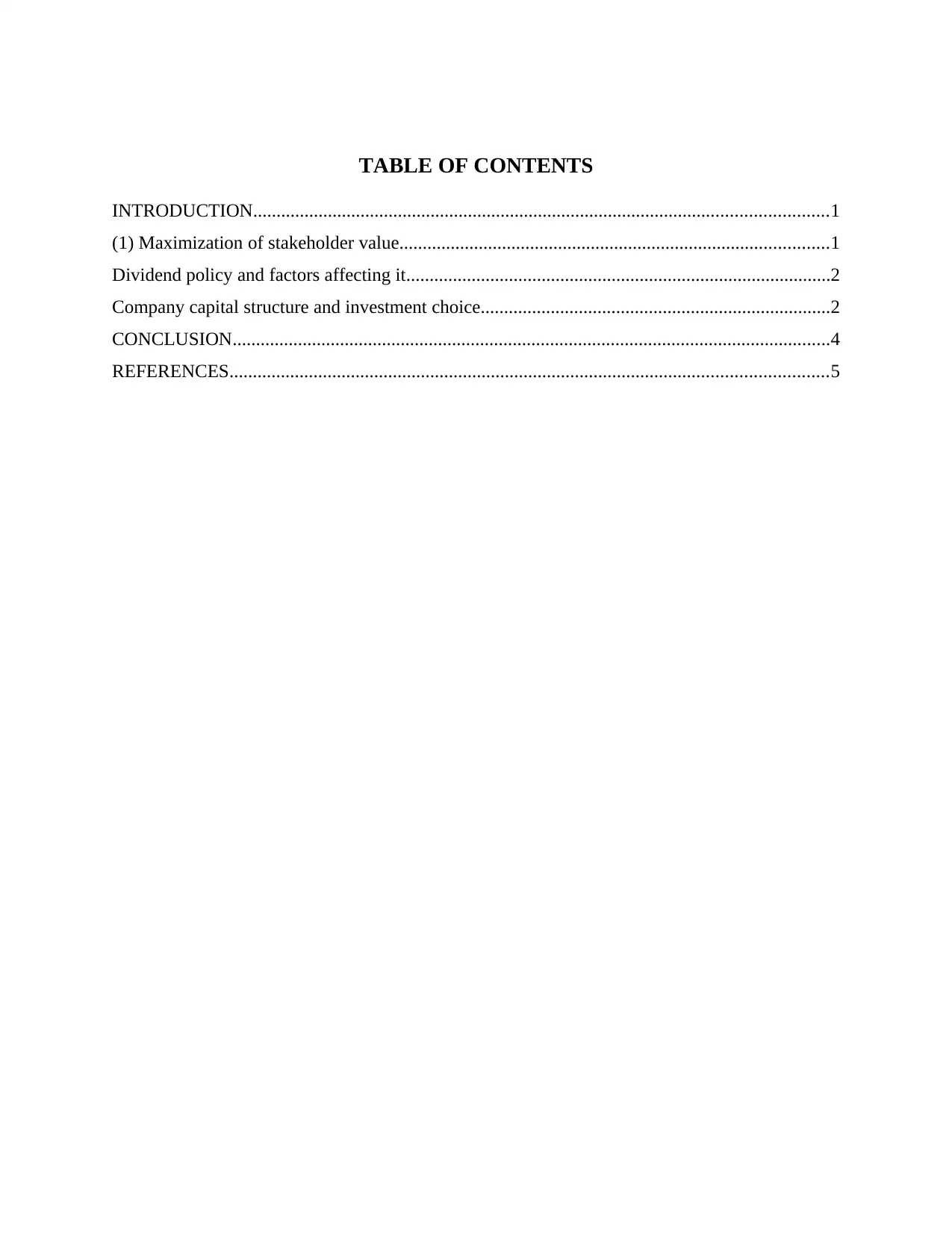
TABLE OF CONTENTS
INTRODUCTION...........................................................................................................................1
(1) Maximization of stakeholder value............................................................................................1
Dividend policy and factors affecting it...........................................................................................2
Company capital structure and investment choice...........................................................................2
CONCLUSION................................................................................................................................4
REFERENCES................................................................................................................................5
INTRODUCTION...........................................................................................................................1
(1) Maximization of stakeholder value............................................................................................1
Dividend policy and factors affecting it...........................................................................................2
Company capital structure and investment choice...........................................................................2
CONCLUSION................................................................................................................................4
REFERENCES................................................................................................................................5
⊘ This is a preview!⊘
Do you want full access?
Subscribe today to unlock all pages.

Trusted by 1+ million students worldwide
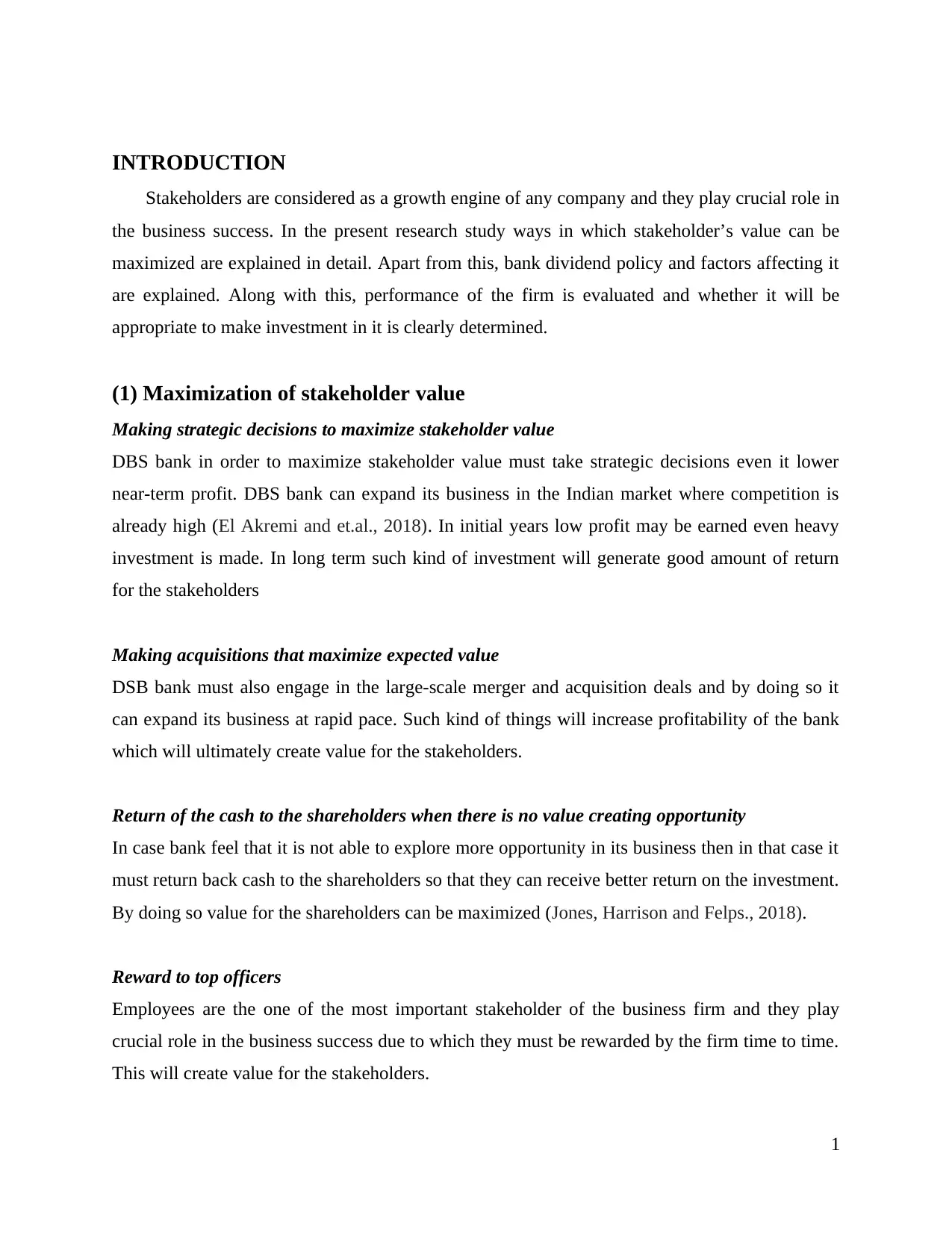
INTRODUCTION
Stakeholders are considered as a growth engine of any company and they play crucial role in
the business success. In the present research study ways in which stakeholder’s value can be
maximized are explained in detail. Apart from this, bank dividend policy and factors affecting it
are explained. Along with this, performance of the firm is evaluated and whether it will be
appropriate to make investment in it is clearly determined.
(1) Maximization of stakeholder value
Making strategic decisions to maximize stakeholder value
DBS bank in order to maximize stakeholder value must take strategic decisions even it lower
near-term profit. DBS bank can expand its business in the Indian market where competition is
already high (El Akremi and et.al., 2018). In initial years low profit may be earned even heavy
investment is made. In long term such kind of investment will generate good amount of return
for the stakeholders
Making acquisitions that maximize expected value
DSB bank must also engage in the large-scale merger and acquisition deals and by doing so it
can expand its business at rapid pace. Such kind of things will increase profitability of the bank
which will ultimately create value for the stakeholders.
Return of the cash to the shareholders when there is no value creating opportunity
In case bank feel that it is not able to explore more opportunity in its business then in that case it
must return back cash to the shareholders so that they can receive better return on the investment.
By doing so value for the shareholders can be maximized (Jones, Harrison and Felps., 2018).
Reward to top officers
Employees are the one of the most important stakeholder of the business firm and they play
crucial role in the business success due to which they must be rewarded by the firm time to time.
This will create value for the stakeholders.
1
Stakeholders are considered as a growth engine of any company and they play crucial role in
the business success. In the present research study ways in which stakeholder’s value can be
maximized are explained in detail. Apart from this, bank dividend policy and factors affecting it
are explained. Along with this, performance of the firm is evaluated and whether it will be
appropriate to make investment in it is clearly determined.
(1) Maximization of stakeholder value
Making strategic decisions to maximize stakeholder value
DBS bank in order to maximize stakeholder value must take strategic decisions even it lower
near-term profit. DBS bank can expand its business in the Indian market where competition is
already high (El Akremi and et.al., 2018). In initial years low profit may be earned even heavy
investment is made. In long term such kind of investment will generate good amount of return
for the stakeholders
Making acquisitions that maximize expected value
DSB bank must also engage in the large-scale merger and acquisition deals and by doing so it
can expand its business at rapid pace. Such kind of things will increase profitability of the bank
which will ultimately create value for the stakeholders.
Return of the cash to the shareholders when there is no value creating opportunity
In case bank feel that it is not able to explore more opportunity in its business then in that case it
must return back cash to the shareholders so that they can receive better return on the investment.
By doing so value for the shareholders can be maximized (Jones, Harrison and Felps., 2018).
Reward to top officers
Employees are the one of the most important stakeholder of the business firm and they play
crucial role in the business success due to which they must be rewarded by the firm time to time.
This will create value for the stakeholders.
1
Paraphrase This Document
Need a fresh take? Get an instant paraphrase of this document with our AI Paraphraser
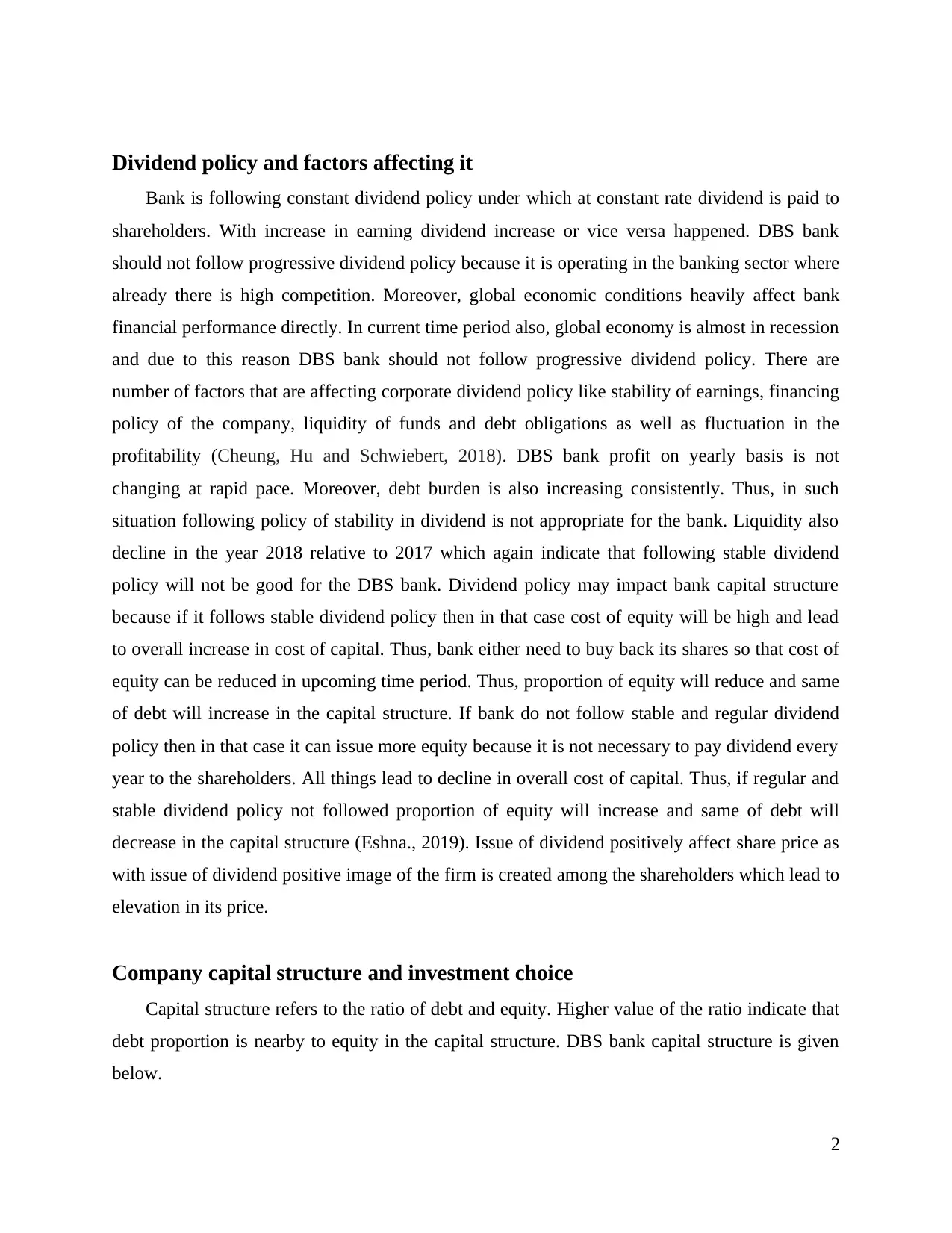
Dividend policy and factors affecting it
Bank is following constant dividend policy under which at constant rate dividend is paid to
shareholders. With increase in earning dividend increase or vice versa happened. DBS bank
should not follow progressive dividend policy because it is operating in the banking sector where
already there is high competition. Moreover, global economic conditions heavily affect bank
financial performance directly. In current time period also, global economy is almost in recession
and due to this reason DBS bank should not follow progressive dividend policy. There are
number of factors that are affecting corporate dividend policy like stability of earnings, financing
policy of the company, liquidity of funds and debt obligations as well as fluctuation in the
profitability (Cheung, Hu and Schwiebert, 2018). DBS bank profit on yearly basis is not
changing at rapid pace. Moreover, debt burden is also increasing consistently. Thus, in such
situation following policy of stability in dividend is not appropriate for the bank. Liquidity also
decline in the year 2018 relative to 2017 which again indicate that following stable dividend
policy will not be good for the DBS bank. Dividend policy may impact bank capital structure
because if it follows stable dividend policy then in that case cost of equity will be high and lead
to overall increase in cost of capital. Thus, bank either need to buy back its shares so that cost of
equity can be reduced in upcoming time period. Thus, proportion of equity will reduce and same
of debt will increase in the capital structure. If bank do not follow stable and regular dividend
policy then in that case it can issue more equity because it is not necessary to pay dividend every
year to the shareholders. All things lead to decline in overall cost of capital. Thus, if regular and
stable dividend policy not followed proportion of equity will increase and same of debt will
decrease in the capital structure (Eshna., 2019). Issue of dividend positively affect share price as
with issue of dividend positive image of the firm is created among the shareholders which lead to
elevation in its price.
Company capital structure and investment choice
Capital structure refers to the ratio of debt and equity. Higher value of the ratio indicate that
debt proportion is nearby to equity in the capital structure. DBS bank capital structure is given
below.
2
Bank is following constant dividend policy under which at constant rate dividend is paid to
shareholders. With increase in earning dividend increase or vice versa happened. DBS bank
should not follow progressive dividend policy because it is operating in the banking sector where
already there is high competition. Moreover, global economic conditions heavily affect bank
financial performance directly. In current time period also, global economy is almost in recession
and due to this reason DBS bank should not follow progressive dividend policy. There are
number of factors that are affecting corporate dividend policy like stability of earnings, financing
policy of the company, liquidity of funds and debt obligations as well as fluctuation in the
profitability (Cheung, Hu and Schwiebert, 2018). DBS bank profit on yearly basis is not
changing at rapid pace. Moreover, debt burden is also increasing consistently. Thus, in such
situation following policy of stability in dividend is not appropriate for the bank. Liquidity also
decline in the year 2018 relative to 2017 which again indicate that following stable dividend
policy will not be good for the DBS bank. Dividend policy may impact bank capital structure
because if it follows stable dividend policy then in that case cost of equity will be high and lead
to overall increase in cost of capital. Thus, bank either need to buy back its shares so that cost of
equity can be reduced in upcoming time period. Thus, proportion of equity will reduce and same
of debt will increase in the capital structure. If bank do not follow stable and regular dividend
policy then in that case it can issue more equity because it is not necessary to pay dividend every
year to the shareholders. All things lead to decline in overall cost of capital. Thus, if regular and
stable dividend policy not followed proportion of equity will increase and same of debt will
decrease in the capital structure (Eshna., 2019). Issue of dividend positively affect share price as
with issue of dividend positive image of the firm is created among the shareholders which lead to
elevation in its price.
Company capital structure and investment choice
Capital structure refers to the ratio of debt and equity. Higher value of the ratio indicate that
debt proportion is nearby to equity in the capital structure. DBS bank capital structure is given
below.
2
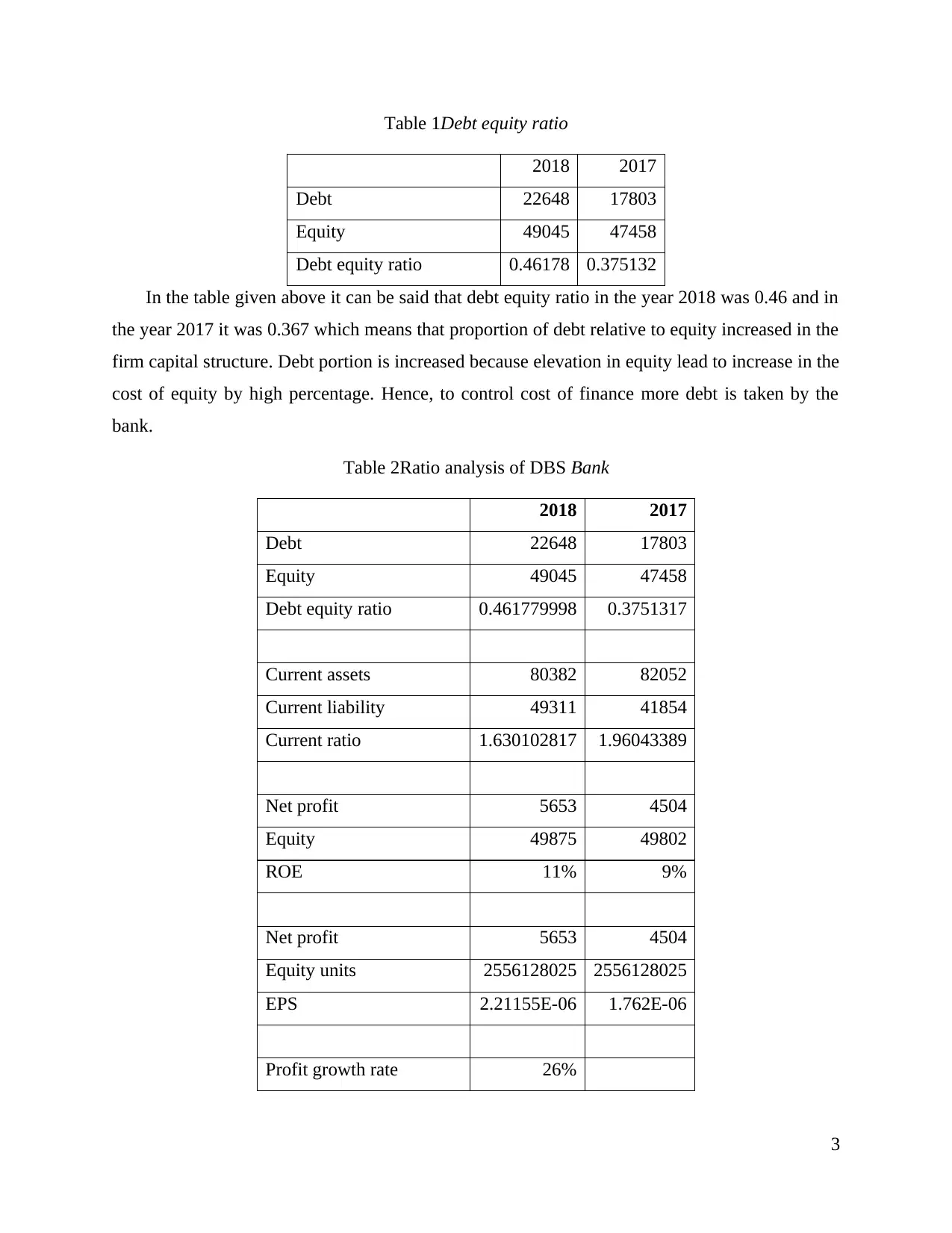
Table 1Debt equity ratio
2018 2017
Debt 22648 17803
Equity 49045 47458
Debt equity ratio 0.46178 0.375132
In the table given above it can be said that debt equity ratio in the year 2018 was 0.46 and in
the year 2017 it was 0.367 which means that proportion of debt relative to equity increased in the
firm capital structure. Debt portion is increased because elevation in equity lead to increase in the
cost of equity by high percentage. Hence, to control cost of finance more debt is taken by the
bank.
Table 2Ratio analysis of DBS Bank
2018 2017
Debt 22648 17803
Equity 49045 47458
Debt equity ratio 0.461779998 0.3751317
Current assets 80382 82052
Current liability 49311 41854
Current ratio 1.630102817 1.96043389
Net profit 5653 4504
Equity 49875 49802
ROE 11% 9%
Net profit 5653 4504
Equity units 2556128025 2556128025
EPS 2.21155E-06 1.762E-06
Profit growth rate 26%
3
2018 2017
Debt 22648 17803
Equity 49045 47458
Debt equity ratio 0.46178 0.375132
In the table given above it can be said that debt equity ratio in the year 2018 was 0.46 and in
the year 2017 it was 0.367 which means that proportion of debt relative to equity increased in the
firm capital structure. Debt portion is increased because elevation in equity lead to increase in the
cost of equity by high percentage. Hence, to control cost of finance more debt is taken by the
bank.
Table 2Ratio analysis of DBS Bank
2018 2017
Debt 22648 17803
Equity 49045 47458
Debt equity ratio 0.461779998 0.3751317
Current assets 80382 82052
Current liability 49311 41854
Current ratio 1.630102817 1.96043389
Net profit 5653 4504
Equity 49875 49802
ROE 11% 9%
Net profit 5653 4504
Equity units 2556128025 2556128025
EPS 2.21155E-06 1.762E-06
Profit growth rate 26%
3
⊘ This is a preview!⊘
Do you want full access?
Subscribe today to unlock all pages.

Trusted by 1+ million students worldwide
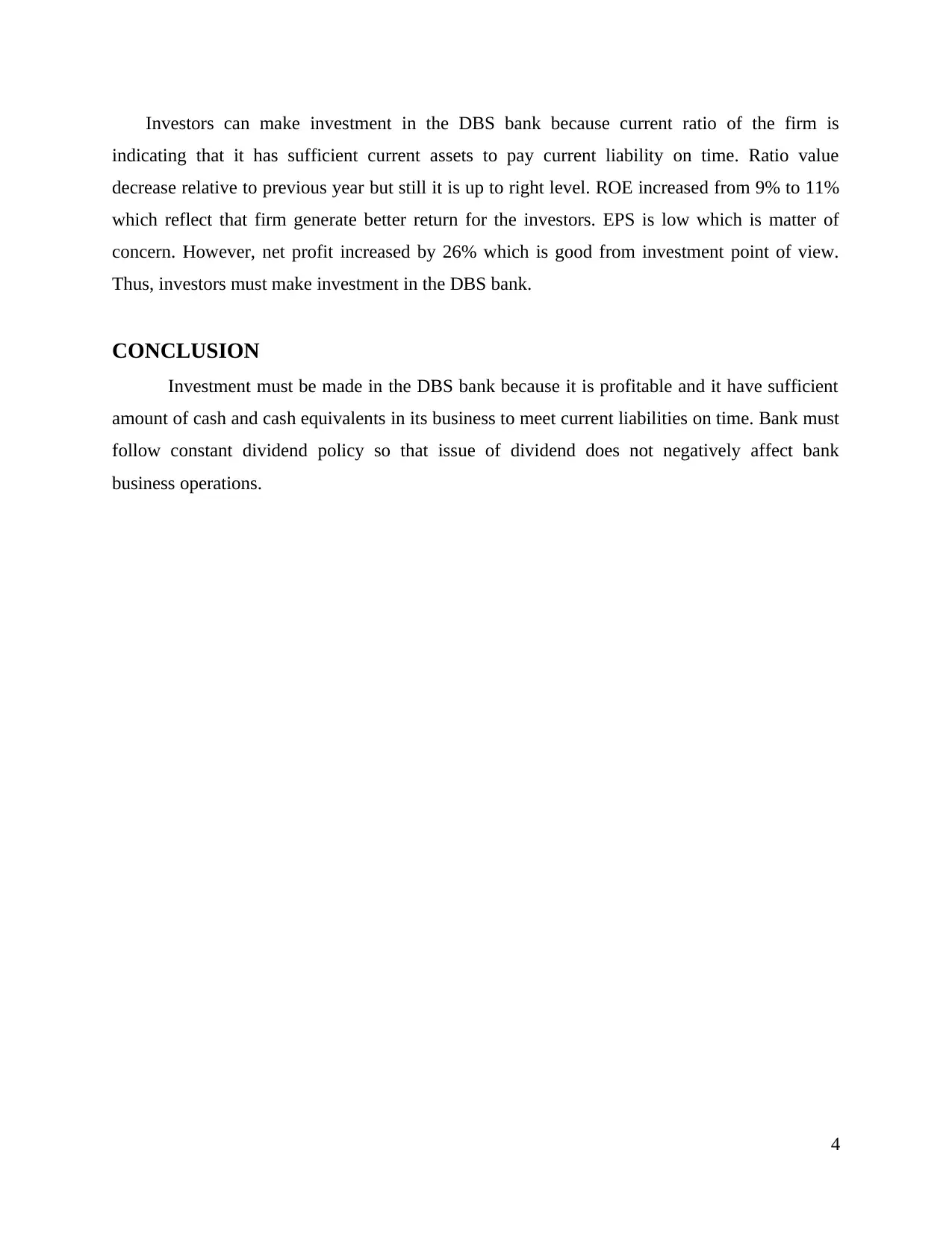
Investors can make investment in the DBS bank because current ratio of the firm is
indicating that it has sufficient current assets to pay current liability on time. Ratio value
decrease relative to previous year but still it is up to right level. ROE increased from 9% to 11%
which reflect that firm generate better return for the investors. EPS is low which is matter of
concern. However, net profit increased by 26% which is good from investment point of view.
Thus, investors must make investment in the DBS bank.
CONCLUSION
Investment must be made in the DBS bank because it is profitable and it have sufficient
amount of cash and cash equivalents in its business to meet current liabilities on time. Bank must
follow constant dividend policy so that issue of dividend does not negatively affect bank
business operations.
4
indicating that it has sufficient current assets to pay current liability on time. Ratio value
decrease relative to previous year but still it is up to right level. ROE increased from 9% to 11%
which reflect that firm generate better return for the investors. EPS is low which is matter of
concern. However, net profit increased by 26% which is good from investment point of view.
Thus, investors must make investment in the DBS bank.
CONCLUSION
Investment must be made in the DBS bank because it is profitable and it have sufficient
amount of cash and cash equivalents in its business to meet current liabilities on time. Bank must
follow constant dividend policy so that issue of dividend does not negatively affect bank
business operations.
4
Paraphrase This Document
Need a fresh take? Get an instant paraphrase of this document with our AI Paraphraser
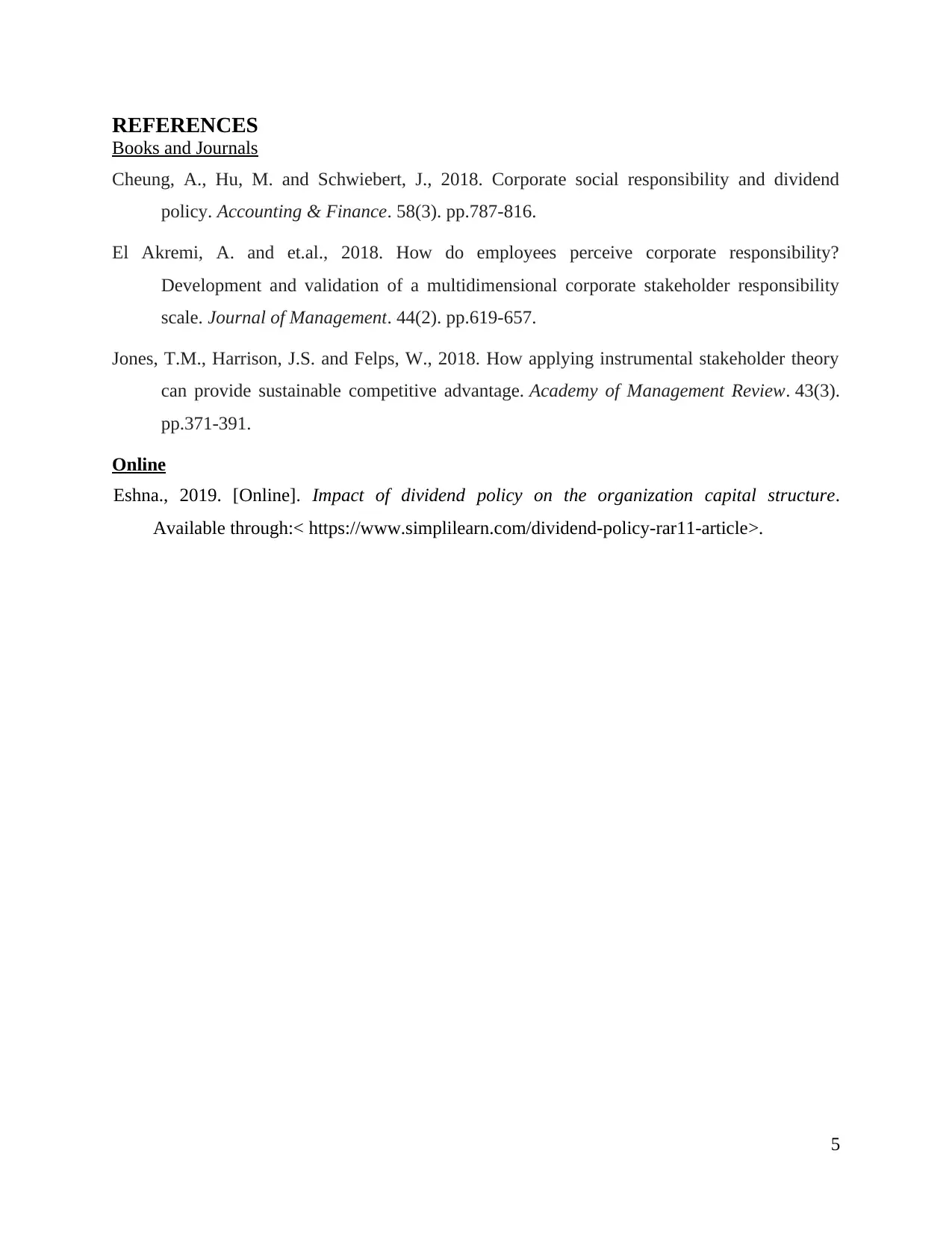
REFERENCES
Books and Journals
Cheung, A., Hu, M. and Schwiebert, J., 2018. Corporate social responsibility and dividend
policy. Accounting & Finance. 58(3). pp.787-816.
El Akremi, A. and et.al., 2018. How do employees perceive corporate responsibility?
Development and validation of a multidimensional corporate stakeholder responsibility
scale. Journal of Management. 44(2). pp.619-657.
Jones, T.M., Harrison, J.S. and Felps, W., 2018. How applying instrumental stakeholder theory
can provide sustainable competitive advantage. Academy of Management Review. 43(3).
pp.371-391.
Online
Eshna., 2019. [Online]. Impact of dividend policy on the organization capital structure.
Available through:< https://www.simplilearn.com/dividend-policy-rar11-article>.
5
Books and Journals
Cheung, A., Hu, M. and Schwiebert, J., 2018. Corporate social responsibility and dividend
policy. Accounting & Finance. 58(3). pp.787-816.
El Akremi, A. and et.al., 2018. How do employees perceive corporate responsibility?
Development and validation of a multidimensional corporate stakeholder responsibility
scale. Journal of Management. 44(2). pp.619-657.
Jones, T.M., Harrison, J.S. and Felps, W., 2018. How applying instrumental stakeholder theory
can provide sustainable competitive advantage. Academy of Management Review. 43(3).
pp.371-391.
Online
Eshna., 2019. [Online]. Impact of dividend policy on the organization capital structure.
Available through:< https://www.simplilearn.com/dividend-policy-rar11-article>.
5
1 out of 8
Related Documents
Your All-in-One AI-Powered Toolkit for Academic Success.
+13062052269
info@desklib.com
Available 24*7 on WhatsApp / Email
![[object Object]](/_next/static/media/star-bottom.7253800d.svg)
Unlock your academic potential
Copyright © 2020–2025 A2Z Services. All Rights Reserved. Developed and managed by ZUCOL.





